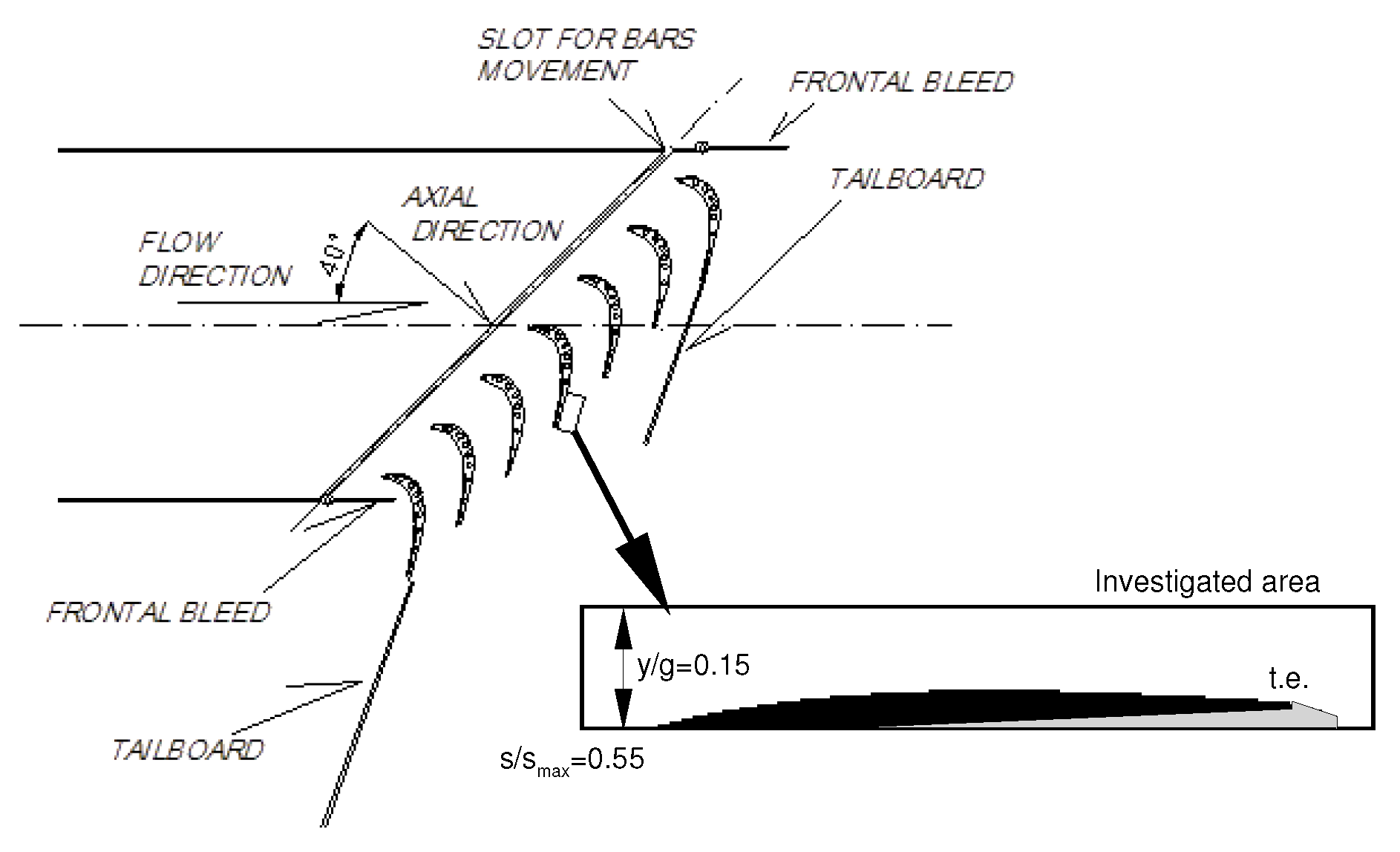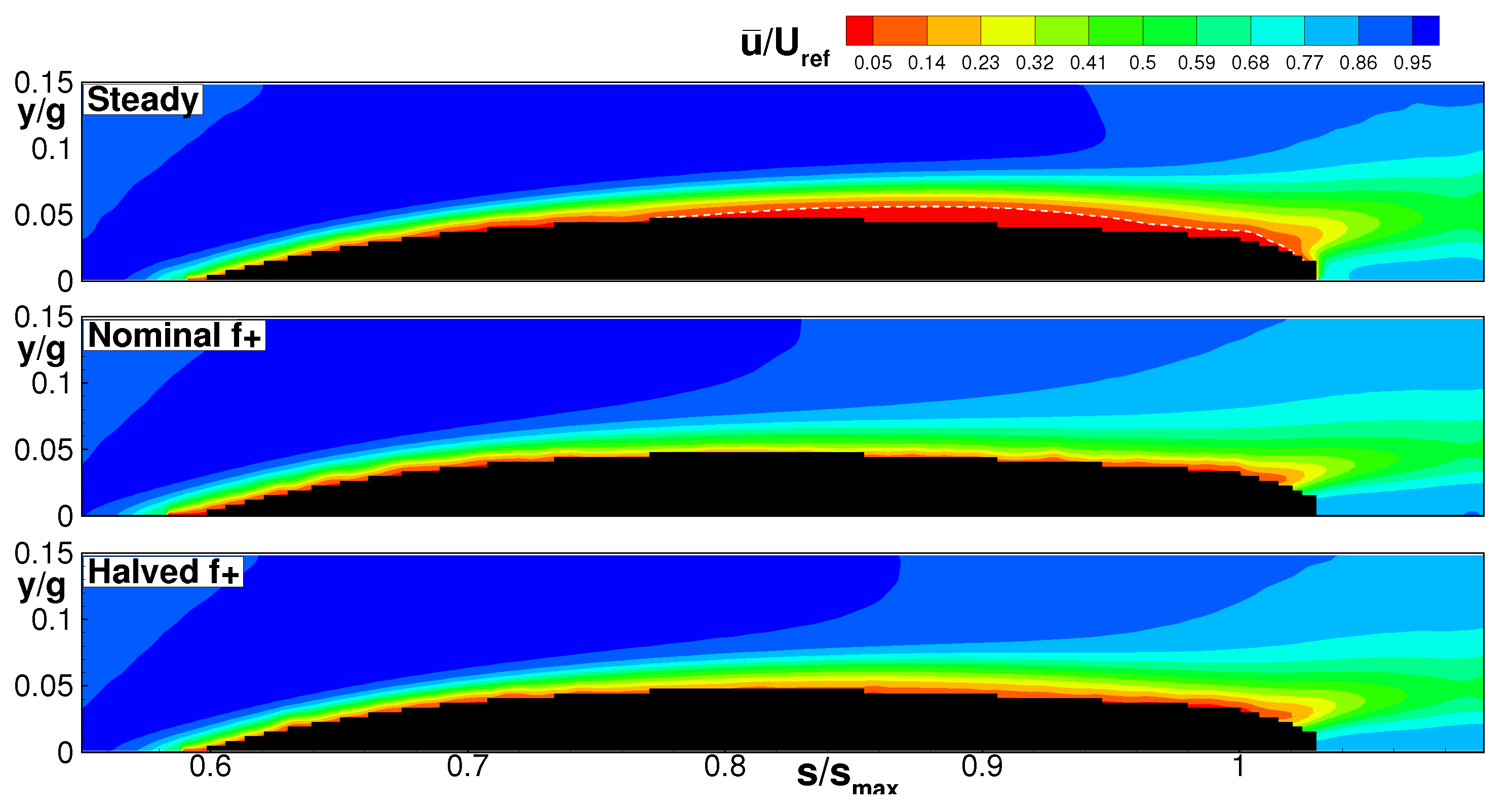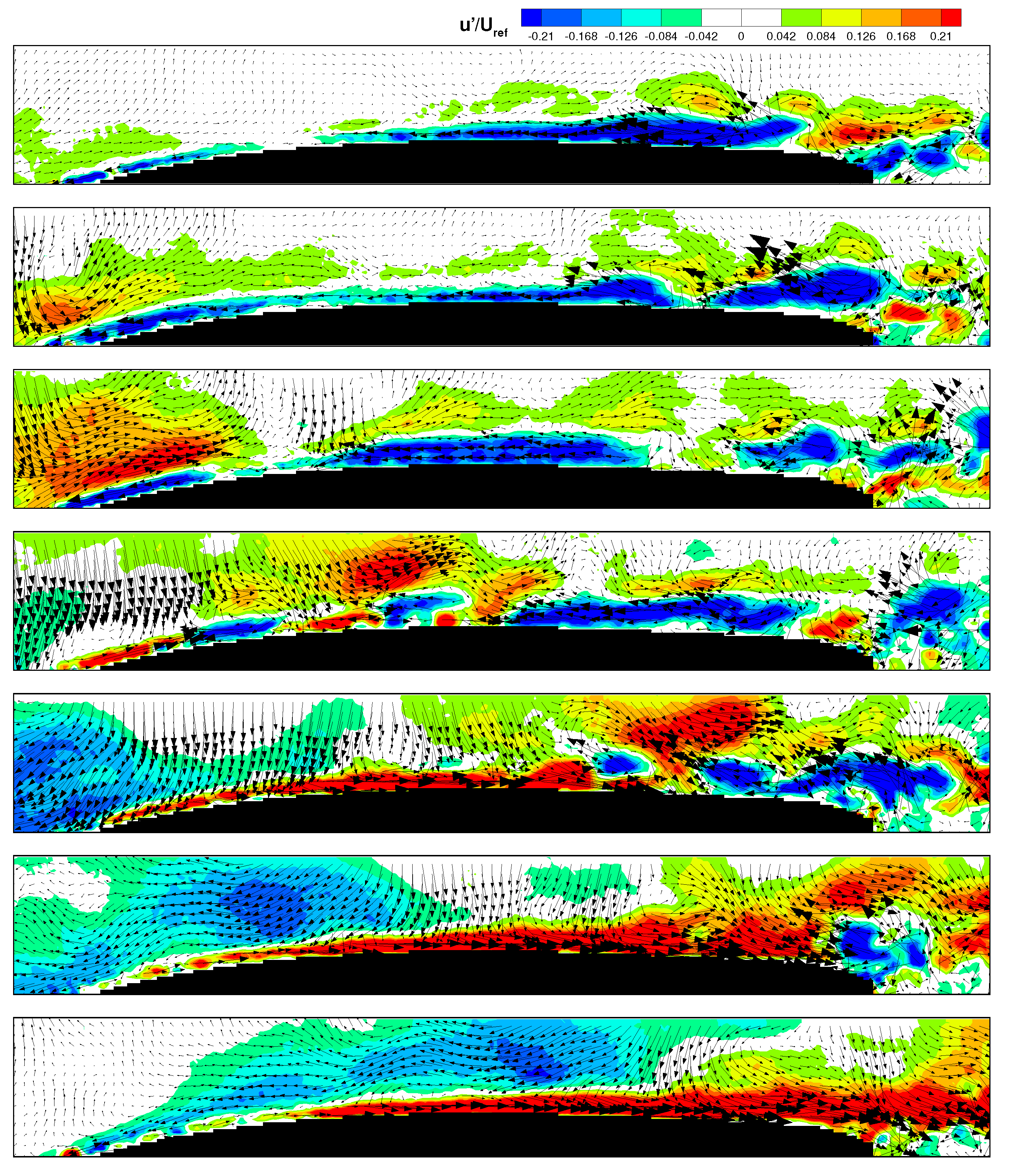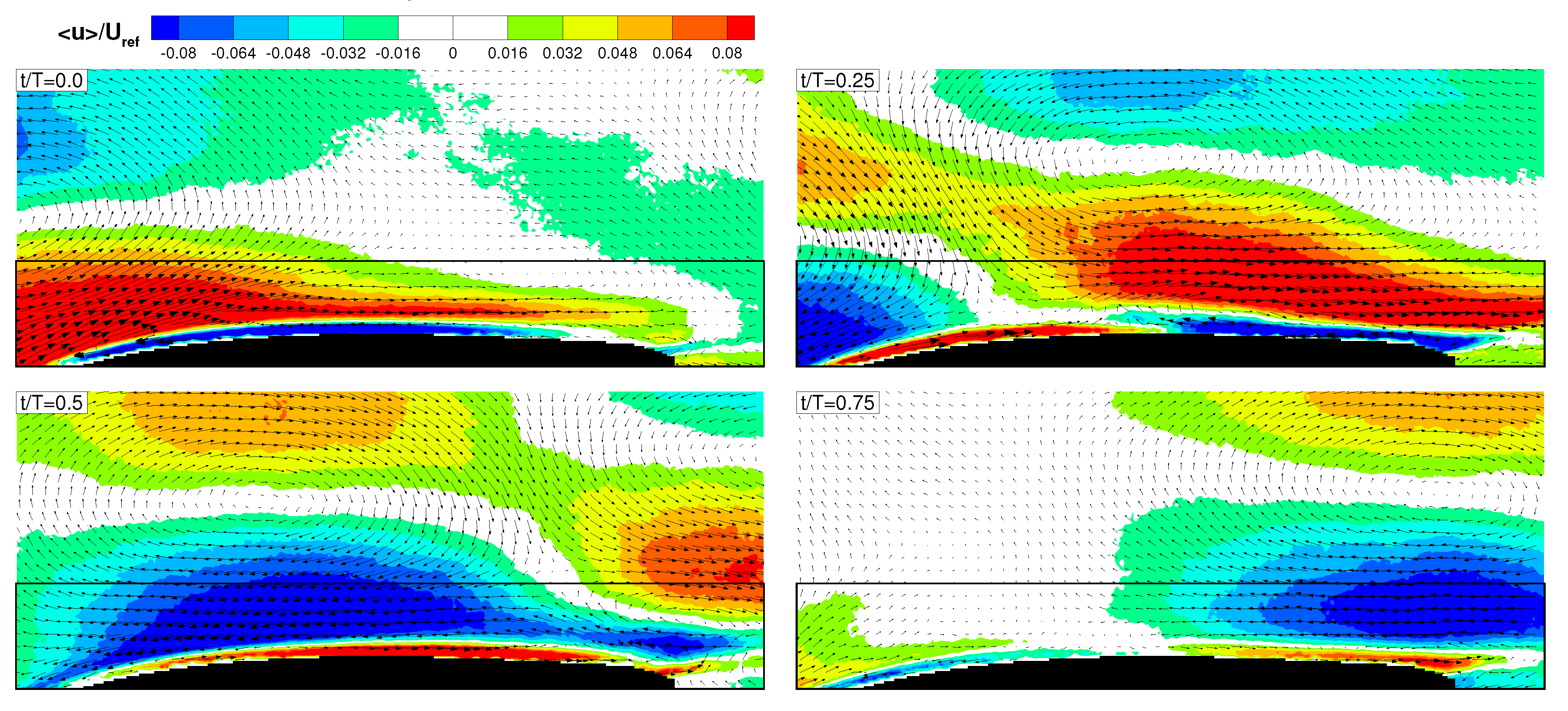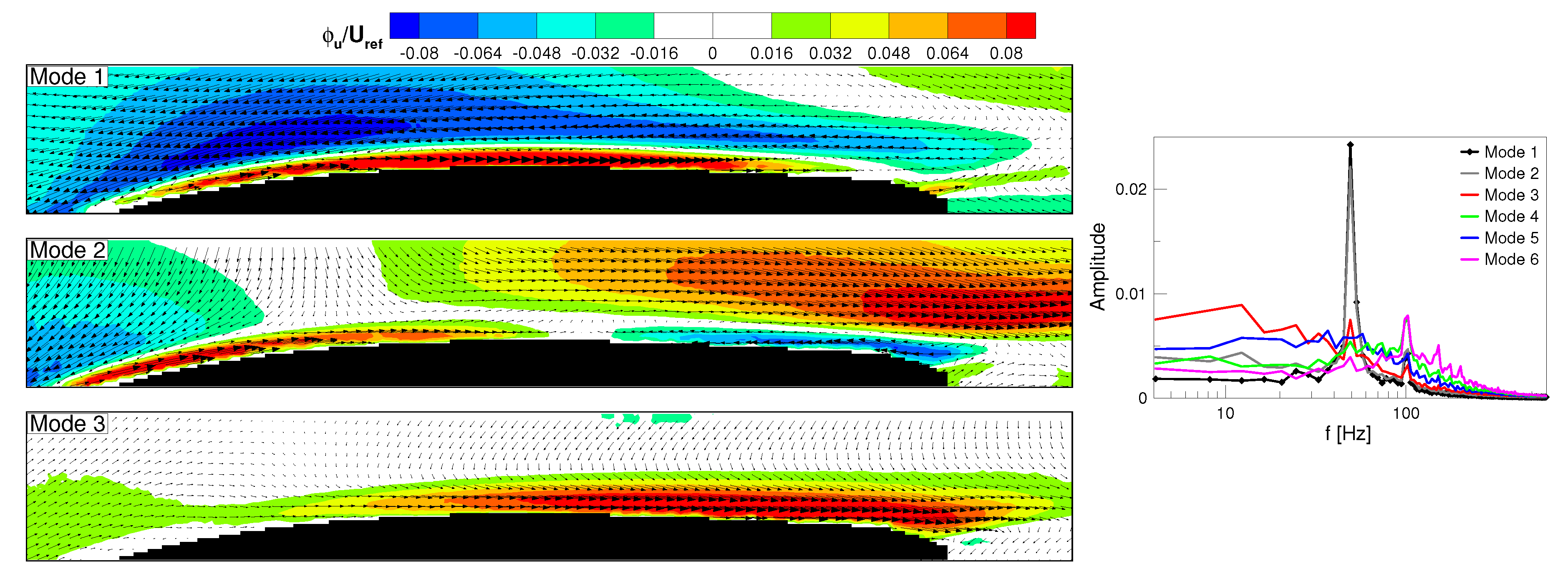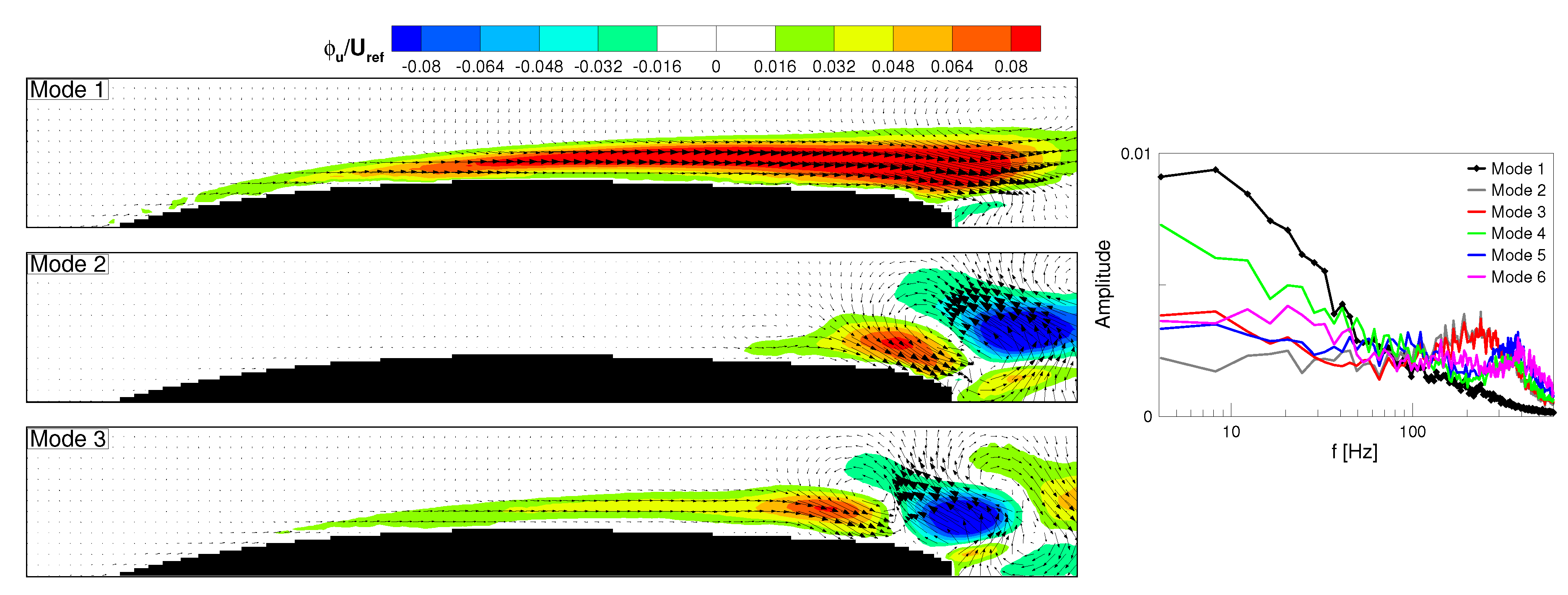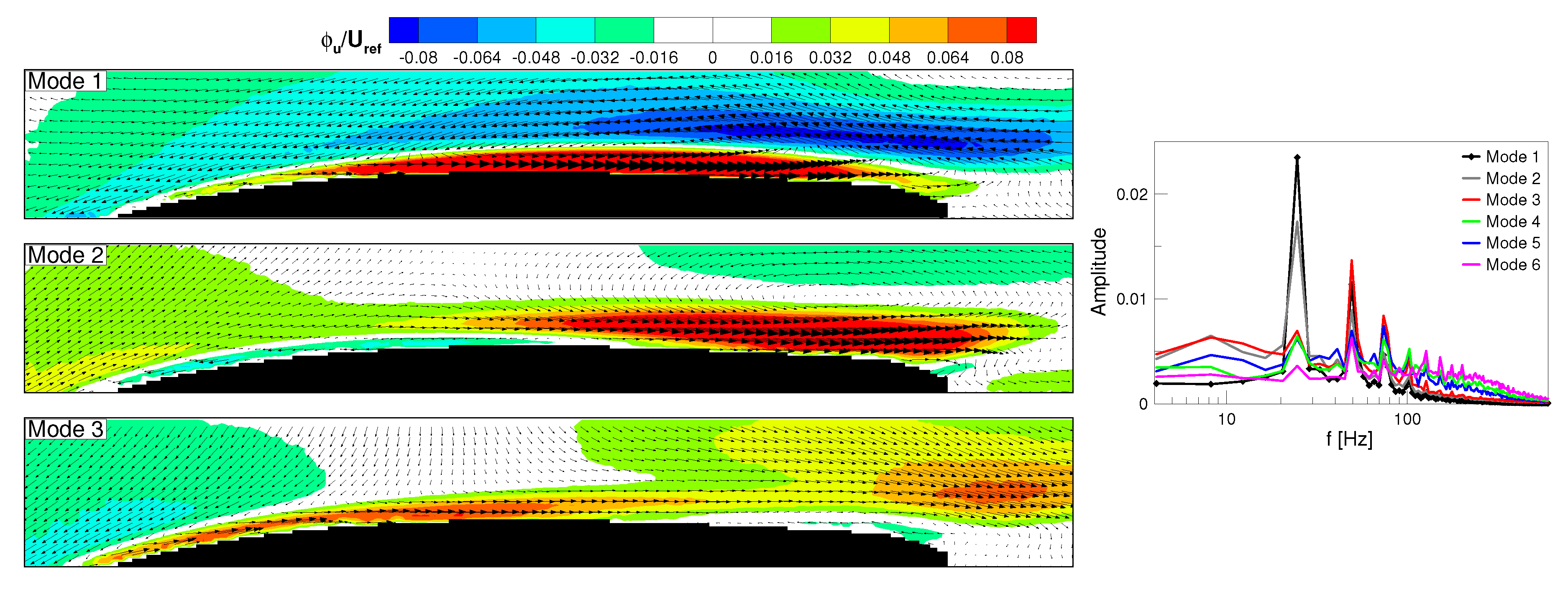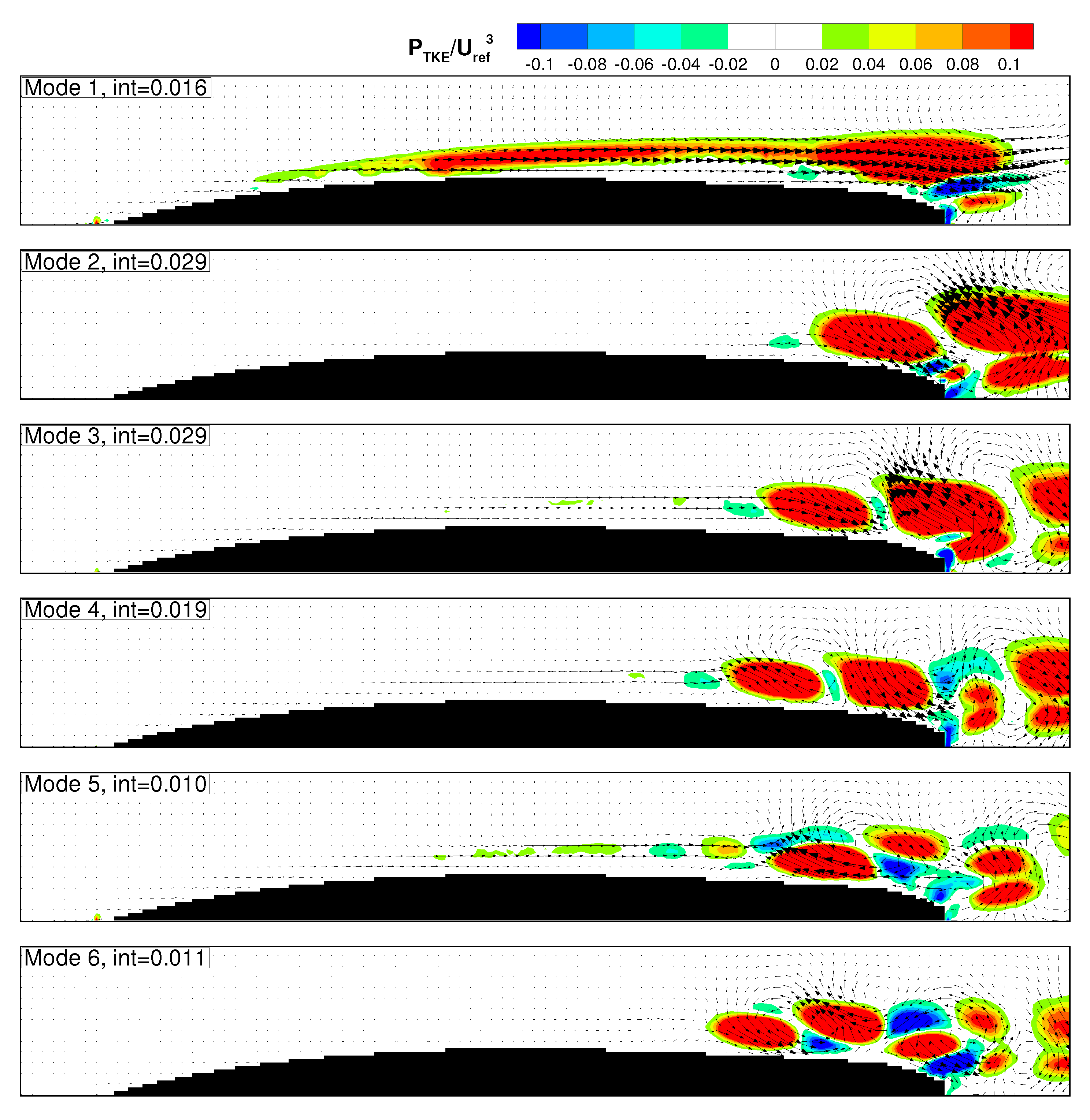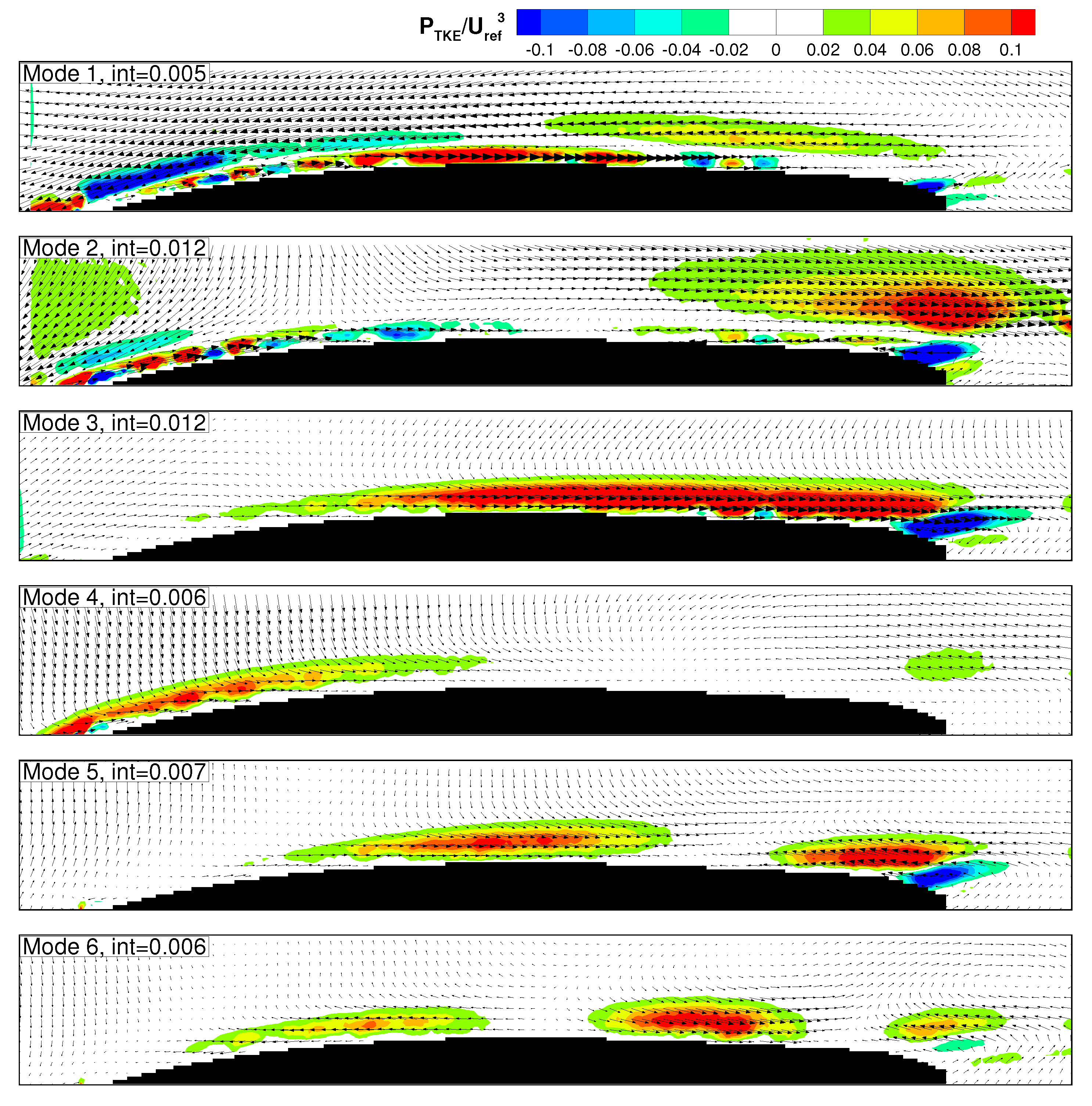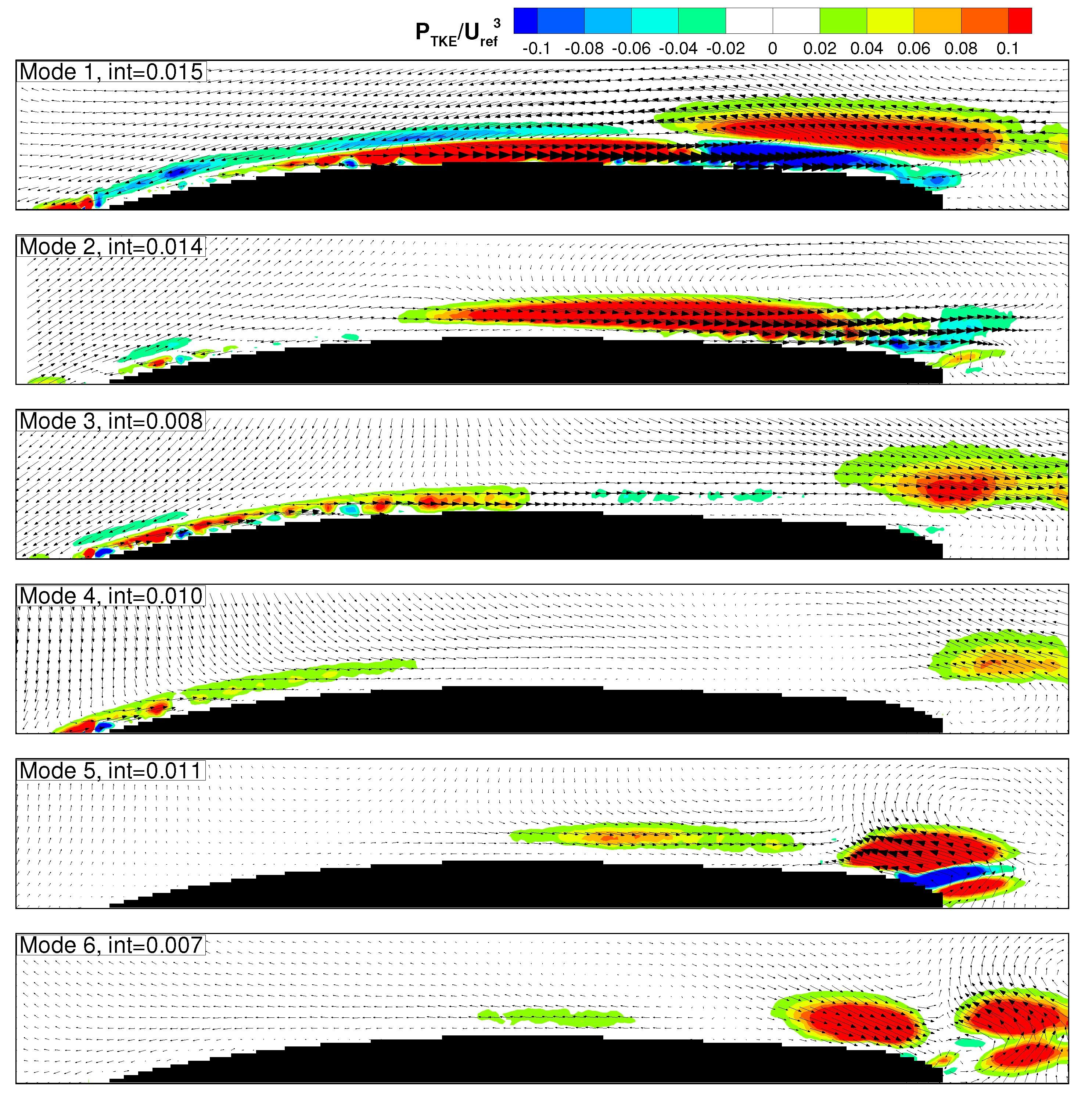The time-mean velocity distributions of the steady state and the two unsteady cases are represented in
Figure 2. The steady state condition shows a separated boundary layer with zero velocity in the aft portion of the blade suction side. The bubble maximum displacement position is located at around
, and the boundary layer does not reattach prior to the trailing edge. Conversely, due to the wake effects, the boundary layer appears completely attached in the nominal unsteady case. These results confirm the well-known beneficial effects of unsteady passing wake in suppressing separation (e.g., [
3,
26]). Time-mean boundary layer separation seems to not be present either for the
condition, even though lower velocity levels can be observed close to the wall, midway between the two previous conditions, as expected. As it will be discussed in the following, this latter condition is characterized by an unsteady separation, and POD will be shown to clearly capture the dominant dynamics responsible for flow oscillations and losses in the different conditions.
3.1. Unsteady Flow Analysis
Thanks to the high frequency response of the TR-PIV instrumentation, the evolution of the flow field can be directly observed to provide a clear view of the flow unsteadiness and complexity. In
Figure 3, evenly time spaced instantaneous perturbation velocity vector maps, (
) according to the Reynolds decomposition, are reported for the case
. The color plots of
are also superposed to empathize the occurrence of localized low and high speed velocity regions during the wake-boundary layer interaction process. About half of the blade passing period is considered. In the first frame the boundary layer develops unperturbed by the wakes. Large negative values of
can be observed in the aft portion of the blade suction side, jointly with the occurrence of large scale vortical structures. Due to the low reduced frequency unsteady boundary layer separation occurs between adjacent wakes, similarly to the results of Opoka and Hodson [
27]. The wake is entering the domain at the second time instant, as it can be deduced by the positive values of
in the fore portion of the suction side away from the wall. While the wake is moving along the fore part of the blade (see the second and third images) the separated flow region in the rear part of the blade still sheds vortices. As soon as the wake interacts with the near wall low velocity region, roll up vortices originate as a consequence of the high shear effects induced by the leading boundary of the wake patch (see the vector maps in the neighboring of the blue area in the fore portion of the blade in the fourth frames). Later, the wake moves further downstream and starts interacting with the separated flow region, and the unsteady behavior of the near wall flow becomes extremely complex. Separation is fully suppressed in the sixth and seventh images, where the region close to the wall is characterized by large positive values of
. In the last frame, the flow appears quite ordered even thought the wake is still interacting with the boundary layer, as highlighted by the elevated negative
values outside the boundary layer region. Wake boundary layer interaction manifests low random oscillations at the end of the interaction process, since the turbulent activity carried by the wake is mainly concentrated at its leading boundary, as described in Lengani et al. [
8].
The unsteady flow field observed here is clearly characterized by stochastic and deterministic (periodic) events due to roll up vortices and wake related effects, respectively. Deterministic fluctuations are classically analyzed by means of phase averaged data, which are able to solve the periodic motion but provide only a statistical representation of the stochastic activities (through the phase-locked root mean square (rms) distribution). On the other hand, POD can be used to characterize the spatio-temporal evolution of both deterministic and stochastic phenomena that contribute to the unsteady flow field just observed, as discussed in previous publications [
8,
17].
The ability of POD of resolving deterministic events can be appreciated by the comparison between the most energetic POD modes and the phase-averaged flow field. In
Figure 4 and
Figure 5, results for the nominal
case are reported as examples.
Figure 4 shows the phase-averaged flow evolution for different phases. The contour plot of the purely periodic component (
, where
is the phase averaged velocity) and the vectorial representation of
are represented in the pictures. The reconstructed phase-averaged velocity field is represented as a plot sequence for four phases within a wake passing period. The extended measurement domain is considered in this case to better appreciate the large scale structures induced by the wakes.
The first instant (
) captures the wake entering the measurement domain, since a large scale counter-clockwise rotating vortex is clearly observable in the fore portion of the measuring domain. As described in Gompertz and Bons [
2], it is due to the low momentum wake flow that impinges on the blade surface opening in two branches. The stream at the leading boundary of the wake induces positive values of
at the edge of the boundary layer, thus provoking high shear effects and the formation of roll up vortices, as previously observed in the instantaneous images. However, since these vortices are not locked to the passing wake, they are smeared out by the phase-averaging procedure and cannot be consequently observed in
Figure 4. The wake jet structure pointing toward the wall can be clearly recognized at
, while the clockwise rotating structure successively appears as the wake moves further downstream (at
and
).
The most energetic POD modes (
Figure 5, left) provide the statistical representation of the large scale structures responsible for the phase-averaged flow field just observed, as also discussed in Bourgeois et al. [
16] for the interpretation of the POD modes computed in the periodic pattern characterizing the wake of a square cylinder. It is worth noting that the POD modes and all the following pictures concern the boundary layer restricted plane (as depicted in
Figure 1), which is indicated by the black box in
Figure 4 for a fast comparison. The vectorial representation shows the POD mode of the two velocity components. The Fourier analysis of the temporal eigenvector (right of
Figure 5) allows identifying passing wake related modes through the occurrence of distinct peaks at the wake passing frequency and higher harmonics.
For the nominal reduced frequency, the first two POD modes depict the velocity perturbation induced by the large scale structures of the wake on the boundary layer. The first POD mode appears similar to the phase averaged representation at the time
, while the second POD mode to that at
. The Fourier spectra of their temporal coefficients are almost identical, and clearly show peaks at the wake passing frequency and higher harmonics (the temporal coefficients are two similar periodic waves shifted of
). The combination of the first two POD modes and the corresponding temporal coefficients provides the reconstructed flow field associated with the periodic motion (i.e., the phase-averaged flow field). Indeed, at the instant when the temporal coefficient of one of the two POD modes is zero, the other mode directly describes the phase-averaged periodic flow map. However, the capability of POD goes beyond the identification of passing wake related effects. Indeed, the third mode in
Figure 5 evidently provides the statistical representation of oscillations not observed in the phase averaged flow field. This mode, according to the Fourier analysis, is poorly associated with the wake passing events, since it shows an amplitude peak at frequencies lower than the wake passing one as well as a smaller peak at the wake passing frequency. Consequently, mode 3 only marginally contributes to the phase-averaged flow field, and it mainly describes the low frequency velocity fluctuations due to elongated structures (i.e., streaky structures) contributing to the boundary layer transition process, similarly to the results shown in a recent authors’ publication [
17]. The POD analysis of the steady case shown in
Figure 6 makes evident the “boundary layer nature” of this mode. Indeed, the first POD mode of this last case is almost identical to the third mode of the nominal unsteady case. The shape of this mode is the trace of streaky structures inside the suction side boundary layer generating as a consequence of the high free-stream turbulence level, as also observed in Lengani and Simoni [
17]. The following modes represent alternating vortical structures that are characterized by fluctuating energy in a frequency range around 200 Hz. These modes provide the statistical representation of the vortical structures shed behind the separation bubble maximum displacement position as a consequence of a Kelvin–Helmholtz instability process [
28,
29,
30]. In the steady case, the most energetic oscillations are due to low frequency activity and the vortex shedding phenomenon, and POD clearly identifies and isolates also these mechanisms. Particularly, the Fourier analysis of mode 1 shows an amplitude peak in the low frequency range (below 100 Hz) that corresponds to that of mode 3 in the nominal
case (note that the ordinates of the Fourier spectra of
Figure 5 and
Figure 6 are different). No oscillations can be observed far from the wall since only the homogeneous free stream turbulence travels across the potential flow region.
For completeness, the POD modes and the Fourier analysis of the eigenvectors are also reported for the halved reduced frequency condition in
Figure 7. The first mode is similar to the first mode of the nominal reduced frequency case, while the second mode resembles the low frequency activity boundary layer mode. Due to the larger time available to the by-pass-like transition process to develop in between two adjacent wakes, for the halved reduced frequency, the boundary layer mode appears more linked to the wake passing frequency. Now, the third mode becomes representative of the wake jet structure, similarly to mode 2 for the nominal reduced frequency. Indeed, again due to larger distance between successive wakes, a steady-like state is able to develop, thus increasing the weight played by the boundary layer most energetic POD mode (which is now the second one). Therefore, the Fourier analysis shows that all of the first six modes are related to the wake passing frequency. Even mode 2 that clearly resembles the first mode of the steady state is then triggered by the wake passing event. In this case, higher order POD modes (shown in the next section) will be also able to trace the intermittent vortex shedding process developing between adjacent wakes. Results shown for the halved condition support the ability of POD in clearly recognizing and splitting, with their relative weight, the different phenomena that simultaneously act generating the complex unsteady flow field previously observed in
Figure 3.
3.2. Turbulence Kinetic Energy Production Analysis
As discussed in the previous sections, the POD can be used to represent and split, on a statistical basis, the structures that characterize the unsteady flow field according to their energy rank. However, as discussed in the data analysis section, the POD can be also used for a further analysis step. Each POD mode can be related to a quota of the TKE production rate, and equivalently to the loss generation rate.
The following three figures (
Figure 8,
Figure 9,
Figure 10) represent for the three cases (steady, nominal and halved
, respectively) the production rate of TKE (
) per POD mode. This quantity has been normalized by the cube of the reference velocity and a unitary length. The integral value of the contribution of each mode on the whole measurement domain has been also computed for each mode, and it is indicated in the figures in order to provide the weight of the different phenomena in producing losses.
The production of TKE for the steady condition (
Figure 8) is mainly related to the Reynolds shear stresses caused by the vortical structures originating from the boundary layer separation, except for the first POD mode. The first mode, as previously observed, is related to low frequency fluctuations of the whole boundary layer region due to streaky structures. However, the integral TKE production rate of this mode is lower than that of the modes related to the vortical structures, since, in this case, the Kelvin-Helmholtz (KH) vortices represent the dominant dynamic producing losses. TKE is mainly produced within the braid region between adjacent vortices, due to the high shear effects (long vectors pointing in the second and fourth quadrant) inducing negative shear stress. Modes 2 and 3 show vortices of the dimension of the boundary layer thickness, while modes 4–6 highlight structures of smaller dimension. Interestingly, local back-scatter can be observed (blue area in the plots) in the finer structures, where the vectors point in the first and third quadrants. As expected, for the steady case, all the sources of losses are confined in the boundary layer region, with the greatest amount of TKE production due to the boundary layer separation related events.
The unsteady case with nominal
(
Figure 9) presents a completely different scenario. The first two modes, related to the large scale structures of the wake, have a lower production rate of TKE with respect to the steady case (being representative of different dynamics). For these modes, the largest production is found within the boundary layer in the region where the roll up vortices caused by the interaction of the wake leading boundary and the boundary layer were previously observed. Significant losses can also be observed in mode 2 at the edge of the boundary layer extending also into the potential flow region, in the surroundings of the end of the profile surface and at the entrance of the measuring domain. This source of losses is due to the deformation of the wake patch during migration (as also described in Michelassi et al. [
5]), which consequently further contributes to the overall losses in the unsteady operation of the LPT cascade. However, in the boundary layer region, the contribution due to the wake related modes together (1 and 2) to the TKE generation rate is lower than the contribution due to the boundary layer related events (modes above 2). Particularly, the third mode gives the largest production rate within the measurement domain. The TKE production into the boundary layer due to modes 3–6 appears significant also in the fore part of the measuring plane as a consequence of the by-pass like transition process forced by the incoming wakes that induces fluctuations also in this part of the suction side. Moreover, in this case, no vortex-like structures are responsible for losses, according to the absence of separation. In addition, regions of negative values of
appear in the plot. Here, the TKE is reconverted to mean flow energy, i.e., back-scatter occurs.
The halved
case shows features of both the previously described cases. The TKE production rate distribution of modes 1, 3 and 4 is similar to that of modes 1, 2 and 4 of the nominal
case. The TKE generation rate (integrated value) related to the large scale structures of the incoming wake for the halved
(modes 1 and 3) is higher than for the nominal case. This is because the roll up vortex caused by the interaction of the wake and the boundary layer is larger for this condition, according to the thicker boundary layer developing between wakes [
11]. Mode 2 (the boundary layer mode) shows losses intermediate between their counterpart for the steady (mode 1) and the nominal unsteady case (mode 3). Modes 5 and 6 are instead related to the dynamics of the unsteady separation since they clearly represent vortical structures shed in the rear part of the blade suction side. The TKE generation rate due to these modes is reduced for this unsteady case with respect to the steady one, according to the intermittent nature of the flow separation.
In order to provide a quantitative picture of the TKE produced in the three different tested conditions, the contributions per mode to the generation of TKE (Equation (
8)) have been integrated in the 2D measurement domain. The results of the integration are reported in
Figure 11, where the cumulative contributions have been normalized by the total production of TKE evaluated in the steady case. The cumulative contribution of the total turbulence production rate per POD mode of the steady case (black line) shows that the first 10 POD modes capture about 70% of the total, while the integration up to the 100th mode provides more than 90% of the total. This simply reflects the fact that the largest production is caused by the large scale vortical structures related to the boundary layer separation.
The total production for the unsteady case is lower for the nominal case, while the halved case stay in between the other two cases. For the unsteady cases, the first ten modes produce a lower percentage of the total when compared with the steady case. Hence, the TKE generation is related to higher order POD modes that typically are related to smaller scale stochastic structures. The halved case presents a steep increase of the TKE production at modes 5–9, which, as previously shown, are related to the intermittent flow separation. Hence, in the rear part of the blade suction side, the suppression of the laminar separation for the unsteady case clearly reduces the losses generated in the boundary layer.
